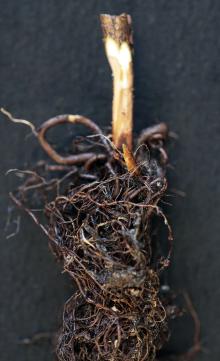See:
Spruce (Picea spp.) - Phytophthora Root Rot
Cause The OSU Plant Clinic has found numerous fungal genera associated with root rots of spruce including Phytophthora, Pythium, Fusarium, Rhizoctonia and Cylindrocarpon. The fungus Ilyonectria destructans (formerly Cylindrocarpon destructans) has often been found alone in many root rot samples of blue and Norway spruce. Cylindrocarpon spp. are common rhizosphere inhabitants as well as non-pathogenic root endophytes but generally do not begin to rot roots until after trees have been stressed. Stresses from media/soil being too wet or dry or wounding from causes such as fertilizer burn or improper storage conditions for bare-root trees can induce disease development.
Several Cylindrocarpon species produce resting structures called chlamydospores that allow the fungus to remain viable in soil for prolonged periods without susceptible host plants. Carbohydrate exudates from roots of susceptible crops stimulate chlamydospore germination in soil. The rhizosphere is colonized quickly and under the right conditions mycelia invades cortical and vascular tissues inducing root decay. These fungi can readily colonize inner surfaces of container walls where they can remain viable between seedling crops. The fungus spreads within nurseries on contaminated soil and by micro- and macro-conidia that are spread by either irrigation or rain water. Warm, wet conditions are conducive to spread of the fungus including water-saturated growing media.
Many different plants including conifers, fruit trees, and ginseng can harbor these fungi.
Symptoms These fungi attack the roots, which rot and die. Roots that remain are brown, stunted, and lack root tips. Smaller roots rot first followed by larger roots that become watersoaked, darken and then rot. Infections may also occur in the root crown region. Trees may show wilting, branch dieback, or other symptoms of inhibited water and nutrient uptake. Sometimes there are few above ground symptoms. Symptoms alone will be similar to those produced by other fungi such as Fusarium.
Cultural control Reduce and eliminate stress conditions that encourage disease development are the key to managing this disease.
- Use soilless potting mix or steam-treated soil and rooting media. Steam 30 min. at 180°F. Keep field soil out of contact with clean media.
- Avoid reusing pots or trays from a previous crop for propagation. If pots or trays must be reused then wash off all debris and soak in a sanitizing solution or treat with aerated steam for 30 min. Also disinfect any tools and equipment that might be used and contaminate the media.
- Maintain adequate fertility for moderate plant growth.
- Monitor soluble salt concentrations regularly. Use media pH and soil wetness appropriate for good crop growth.
- Remove plant debris during production and thoroughly clean and sterilize the greenhouse between production cycles.
- Remove and destroy all infected plants and plant debris.
- In the field, rotate planting beds with nonsusceptible hosts such as small grains to reduce fungal inoculum levels. Avoid legume cover crops. Keeping beds weed free and fallow with periodic tilling during inter-rotational seasons is even better.
Chemical control Pre-plant soil fumigation has been helpful for transplant beds. There are no fungicides specially labeled for Cylindrocarpon on spruce. The fungicides Cleary 3336F, Dithane 75DF, Heritage, and Iprodione E-Pro reduced the growth of Cylindrocarpon mycelia in culture but would have an unknown effect if used on trees. Drenching the soil with fungicides after symptoms have developed will be ineffective.
Reference Dumroese, R. K., and James, R. L. 2005. Root diseases in bareroot and container nurseries of the Pacific Northwest: epidemiology, management, and effects on outplanting performance. New Forests, 30:185-202.
James, R. L. 2012. Cylindrocarpon root disease. In Cram, M.M., Frank, M.S., and Mallams, K.M. Forest nursery pests. Washington DC: US Department of Agriculture, Forest Service. Ag handbook # 680.


